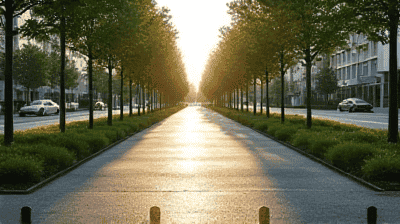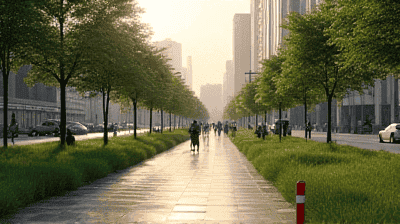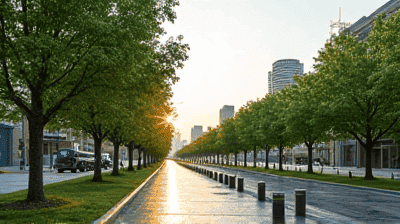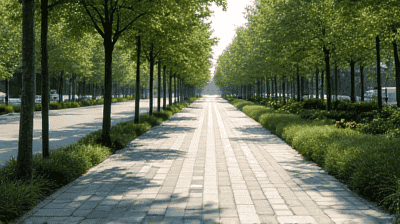
As urban environments continue to expand, city dwellers are increasingly feeling the effects of elevated temperatures known as the urban heat island effect. This phenomenon occurs when urban areas become significantly warmer than their rural surroundings due to human activities, extensive use of dark surfaces, and a lack of vegetation. Rising temperatures can lead to serious public health issues, increased energy costs, and environmental degradation.
The urban heat island (UHI) effect describes the phenomenon wherein urban areas exhibit higher temperatures than their rural counterparts. Typically, cities can be several degrees warmer, especially during the summer months. This temperature difference is primarily due to:
Absorption of Heat: Urban surfaces, particularly asphalt and concrete, absorb and store heat during the day. At night, these surfaces release heat slowly, preventing a drop in temperature.
Lack of Vegetation: Vegetation helps to cool the environment through shading and evapotranspiration. The removal of trees and plants during urban development leads to a loss of this natural cooling effect.
Energy Consumption: Increased energy use in urban settings, particularly for heating and air conditioning, generates waste heat, further contributing to elevated temperatures.
Several factors contribute to the UHI effect, including:
Impervious Surfaces: Paved areas like roads, parking lots, and buildings are significantly less effective at reflecting sunlight and cooling than natural landscapes.
Geometry of Urban Structures: Buildings can create canyons that trap heat and impede airflow, exacerbating warming effects.
Anthropogenic Activities: Activities such as transportation, industrial operations, and waste disposal generate significant heat, adding to the overall temperature in urban areas.
Limited Green Spaces: A lack of parks and green areas means fewer cooling sources to counter the heat generated by human activity and impervious surfaces.
The UHI effect can be assessed using various methods:
Surface Temperature Measurements: Instruments like infrared thermometers can measure surface temperatures to determine heat distribution within urban areas.
Satellite Remote Sensing: Satellite imagery can provide insights into temperature variations across large urban landscapes, helping researchers identify UHI hotspots.
Meteorological Data: Local weather stations can monitor temperature fluctuations over time, revealing patterns associated with UHI.

The implications of UHI extend beyond discomfort; they have far-reaching consequences for public health, energy use, and local ecosystems:
High temperatures associated with the UHI effect can lead to:
Heat-Related Illnesses: Prolonged exposure to high temperatures increases the risk of heat exhaustion, heat stroke, and other heat-related health issues.
Increased Respiratory Problems: Higher temperatures can exacerbate air quality issues, leading to higher levels of ground-level ozone and respiratory illnesses.
Mental Health Strain: Extended periods of heat can cause stress and discomfort, impacting mental well-being.
Cities experiencing UHI effects often face economic challenges, such as:
Higher Energy Costs: Increased demand for air conditioning during hotter periods leads to elevated energy bills for residents and businesses.
Decreased Productivity: Extreme heat can reduce worker productivity, especially in outdoor jobs, leading to economic losses.
Infrastructure Damage: Increased temperatures can damage roads, bridges, and buildings, requiring more frequent repairs and maintenance.
The UHI effect poses significant challenges to local ecosystems:
Biodiversity Loss: Altered temperatures can impact local flora and fauna, leading to habitat degradation and loss of biodiversity.
Water Quality Issues: Increased runoff from impervious surfaces can lead to pollution in local water sources, affecting aquatic ecosystems.
Altered Weather Patterns: The UHI effect can influence local weather dynamics, potentially leading to changes in precipitation patterns.
To counteract the impact of urban heat islands, cities can implement a variety of strategies centered around reflective pavements and green spaces.
Reflective pavements utilize materials designed to reflect sunlight and absorb less heat compared to traditional asphalt. These materials can significantly mitigate the UHI effect.
Reduced Surface Temperatures: Reflective materials can lower surface temperatures by reducing heat absorption, leading to cooler surrounding areas.
Energy Savings: By lowering the temperature of paved surfaces, cities can reduce energy consumption for cooling, leading to lower energy costs.
Improved Air Quality: By combating the UHI effect, reflective pavements can contribute to better air quality, reducing heat-related air pollutants.
Cool Asphalt: Cool asphalt is designed to reflect more sunlight than traditional asphalt, using lighter colors and specialized aggregates.
Porous Pavements: Porous materials allow water to infiltrate, reducing runoff and the heat generated from water evaporation.
Reflective Coatings: Applying reflective coatings to existing pavements can enhance their ability to reflect sunlight without complete replacement.
Several cities have successfully implemented reflective pavements, yielding positive results:
Los Angeles, California: Los Angeles introduced cool pavement initiatives that have significantly lowered surface temperatures in targeted neighborhoods.
Tokyo, Japan: The city has implemented reflective pavement strategies in various areas, promoting lower temperatures and energy savings.
Integrating green spaces into urban environments can provide significant cooling benefits through shade, evapotranspiration, and other natural processes.
Temperature Reduction: Trees and vegetation reduce surface temperatures by providing shade and releasing moisture into the air through transpiration.
Air Quality Improvement: Vegetation can filter pollutants from the air and provide oxygen, enhancing overall air quality.
Enhanced Aesthetic Value: Green spaces contribute to the beauty of urban areas, making them more inviting for residents and visitors.
Urban Parks: Well-designed urban parks provide recreational opportunities while helping to cool the environment.
Street Trees: Planting trees along streets not only enhances the aesthetic appeal but also provides necessary shade to pedestrians.
Green Roofs: Installing green roofs on buildings offers a dual benefit of insulation and heat reduction, enhancing energy efficiency.
Community Gardens: Community gardens enable residents to engage in gardening while promoting green space and improving local biodiversity.
Cities around the world have successfully expanded green spaces as a means of combating UHI:
New York City, New York: The city’s Million Trees initiative aimed to plant a million trees across the five boroughs, significantly increasing tree coverage and lowering temperatures.
Singapore: Known for its extensive greenery, Singapore has integrated vertical gardens and rooftop parks into its urban landscape, contributing to cooling effects and biodiversity.
An integrated approach that combines reflective pavements with green spaces can maximize cooling effects. Strategies include:
Green Alleys: Transforming traditional alleys into green corridors with permeable paving, vegetation, and reflective materials can create cooler, multifunctional spaces.
Cool Roads: Implementing reflective pavements alongside tree planting and green spaces can create a synergistic effect that further reduces urban temperatures.
Water Features: Incorporating fountains, ponds, and other water features in public spaces can enhance evaporative cooling and improve the urban microclimate.

Effective implementation of reflective pavements and green spaces requires a comprehensive approach involving planning and policy considerations:
Integrating cooling strategies into urban planning is essential for long-term success:
Zoning Regulations: Developing zoning regulations that encourage green spaces, tree planting, and reflective materials can support UHI mitigation efforts.
Development Incentives: Offering incentives to developers for incorporating green roofs, reflective pavements, and landscaping in new projects can foster sustainability.
Community involvement is crucial in the planning and implementation of cooling solutions:
Public Awareness Campaigns: Educating residents about the benefits of reflective pavements and green spaces can drive community support and participation.
Participatory Design: Involving local communities in the design and implementation of green spaces ensures that these areas meet the needs and preferences of residents.
Ongoing monitoring and evaluation of UHI mitigation strategies are vital for understanding their effectiveness:
Temperature Assessments: Conducting regular temperature measurements can help track progress and effectiveness of cooling initiatives.
Public Feedback: Collecting feedback from residents about the usability and comfort of green spaces can guide future improvements and interventions.
Reducing urban temperatures through reflective pavements and green spaces not only provides environmental and health benefits but also leads to economic advantages:
Lowering temperatures reduces the demand for air conditioning, leading to significant cost savings for residents and municipalities:
Reduced Peak Demand: Minimizing peak energy consumption can alleviate stress on power grids and reduce the need for additional infrastructure expansions.
Lower Energy Bills: Households can experience decreased energy bills, freeing up resources for other necessities.
Neighborhoods with ample green spaces and cooling measures tend to experience higher property values:
Aesthetic Appeal: Well-maintained parks and green areas enhance the attractiveness of neighborhoods, driving property demand.
Health Benefits: The improved quality of life associated with cooler temperatures and enhanced public health can boost property values in affected areas.
Investing in cooling strategies can lead to resilient urban environments that can better cope with extreme weather events:
Reduced Health Costs: Lower temperatures and improved air quality lead to fewer heat-related illnesses, translating into lower healthcare costs for individuals and communities.
Sustaining Livelihoods: Cooler urban environments can support outdoor businesses and activities, contributing to local economic vitality.

As urbanization continues to rise and the impacts of climate change become more pronounced, innovation will play a crucial role in expanding cooling solutions:
Incorporating smart technologies in urban planning can enhance the effectiveness of reflective pavements and green spaces:
Data-Driven Decision Making: Utilizing data analytics to monitor temperatures and identify UHI hotspots can help prioritize interventions in the most affected areas.
Automated Irrigation Systems: Employing smart irrigation systems in green spaces can maintain vegetation without excessive water use, optimizing resource management.
Investing in research to develop new materials and strategies will be key to enhancing cooling solutions:
Innovative Pavement Materials: Ongoing research into new reflective pavement technologies can yield materials that maximize cooling while minimizing costs.
Sustainable Landscaping Practices: Research into drought-resistant plants and sustainable landscaping approaches can contribute to effective green space management.
Innovative policy frameworks can support the widespread implementation of cooling strategies:
Green Infrastructure Standards: Establishing standards for green infrastructure in urban development can ensure consistent and effective cooling solutions.
Climate Action Plans: Integrating reflective pavements and green spaces into climate action plans can highlight their importance in combating urban heat islands.
The urban heat island effect poses a significant challenge for cities worldwide, impacting public health, energy consumption, and environmental quality. However, through the strategic implementation of reflective pavements and the expansion of green spaces, cities can effectively mitigate these warming effects.
By investing in cooling solutions, all urban stakeholders—governments, residents, and businesses—can work together to create healthier, more sustainable cities that enhance the quality of life for all residents. As we move forward in addressing the impacts of climate change and urbanization, embracing innovative strategies for cooling will be essential to build resilient urban environments for generations to come.